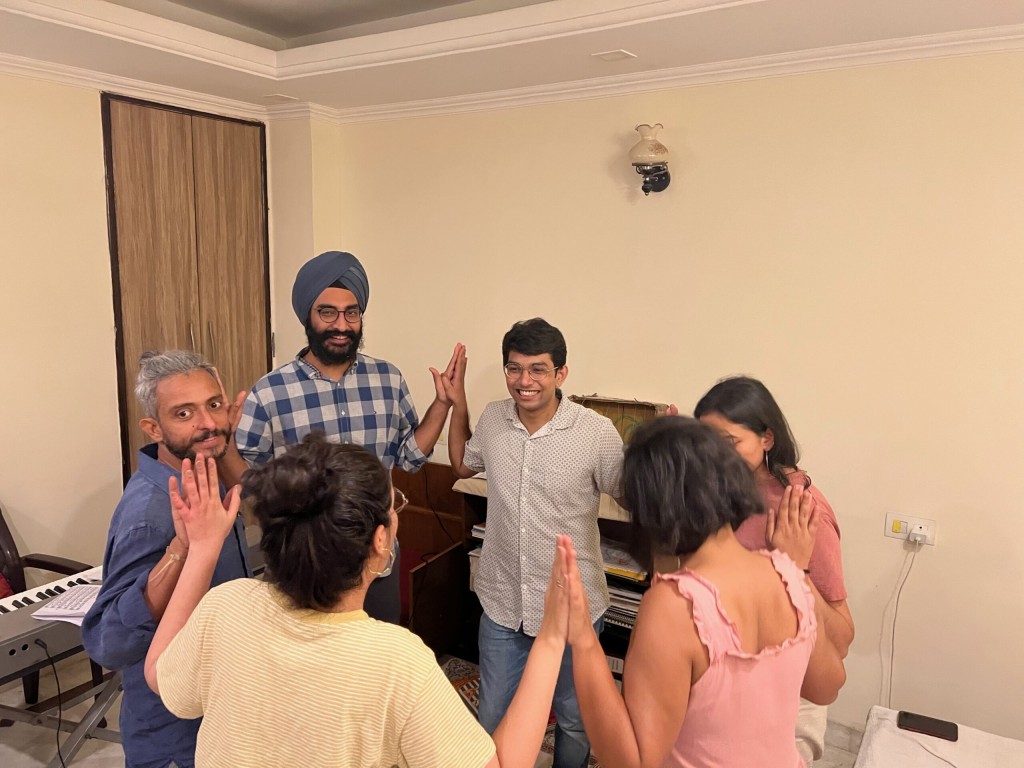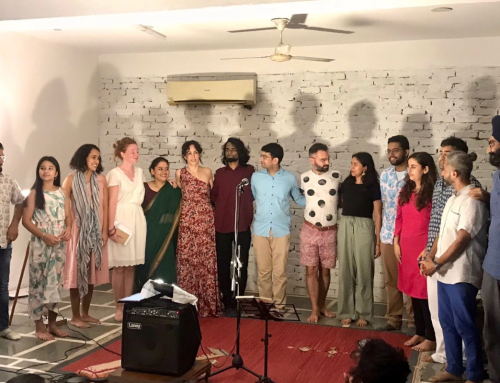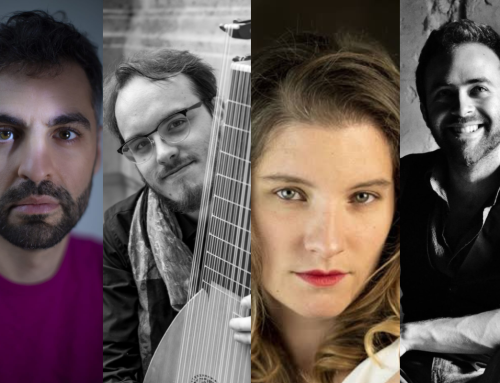Curated and Designed by Ankita Naik, Taashi Sharma, Bhanu Sharma, Subhadra Kamath, Chayan Adhikari | 31st July 2022
Edited by Anubhuti Sharma
Curated and Designed by Ankita Naik, Taashi Sharma, Bhanu Sharma, Subhadra Kamath, Chayan Adhikari | 31st July 2022
Edited by Anubhuti Sharma
One of our most beloved programmes at Lilanoor, The Vocal Circle, is a space of comfort and discovery where people get together one hour every week to explore sounds, work on songs from different cultural contexts, experiment with harmonies and explore the potential of creating new affinities and collectives through music and sound. The idea is to spend an hour every week, doing the one thing which has rightly been called one of the greatest joys there is – that of singing together! It brings people together and makes the heart smile, while simultaneously exploring complex musical ideas in a way that makes time fly.
The love shown by students and artists towards these sessions made us want to delve a little deeper into ensemble singing and choir as a genre, how it began, what are the types and how it makes one feel.
How did ensemble singing begin? Is it mostly religious?
Ensemble can be understood as the act of people coming together. It predates choir in the sense that ensemble singing has been happening from the very beginning of society. In tribal societies till date, there is an idea of people gathering, singing and dancing together. Ensemble singing is related to an idea of community, a kind of collective. This collective could be a religious collective, a political collective or an aesthetic collective with a particular artistic expression like that of a choir. In other words, choir is one of the many variations of ensemble singing.
While ensemble singing has always been alive in different forms and difficult to trace to a single origin, choir singing is traced back to Christianity – singing that took place in church. It is around the 8th and 9th centuries that we see a musical revolution within Christianity as a consequence of which certain passages, psalms and chants are set to music. This raises the stakes of the choir and it becomes a higher form in relation to other kinds of ensemble singing practices, and becomes an integral part of the very institution of Christianity.
The emergence of choir within Christianity has a very interesting relationship with voice. Voice was considered to be a threat to the word of God. It posed the danger of creating pleasure by swaying the listener with the power and flow of the voice and taking the attention away from God. Choir interestingly became a way of diluting the dangers of the individual voice and emphasizing on the word of God by bringing listeners back to the meaning of the word. Whether it succeeded in curbing the pleasure of music or not is a different story.
It is in the 15th and 16th centuries that Christianity moves towards a more secular logic and the church is under question. At this time, the word choir also became secularized and democratized into the different kinds of meanings that choir has today – as people in different contexts coming together to sing. It could be about the glory of god, politics, love or anything under the sun.
Choir is also often confused with the Chorus in ancient Greek drama. However, the two are very different. The chorus in Greek drama marked a change or transition from ritual performance. With the chorus, for the first time something begins which is drama. Chorus becomes an integral part of Greek drama, particularly ancient Greek tragedy. In these plays, it performed the role of the conscience of society – the chorus knew everything.
Irrespective of what the characters spoke, the chorus was something like God, it warned the characters against wrong. It had a specific function which was related to the idea of fate or destiny in Greek drama. Woody Allen’s Mighty Aphrodite is a fun take on the chorus of Greek drama.
Are choirs the main/only form of singing in groups?
Certainly not! Different parts of the world, and different eras have developed their own forms of singing ensembles based on their social milieu and behavioural currents – as Judith Blau puts it – ‘Music as a Social Circumstance’. In fact, there have been variations and types even within choirs themselves. As we move towards more creative forms of organisation, ensemble singing too is undergoing change.
Folk and tribal cultures not just in India, but across the world have always used music and dance as forms of building communities and togetherness.
The Vocal Circle at Lilanoor
Where does the Lilanoor Vocal Circle fit in – among these types?
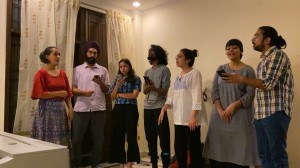 The Vocal Circle is a mini-lab to experiment with different voices, music and sounds, stories and more. Most of us humans can sing, TVC serves to remind us of this, and that it is always worth it to push ourselves to discover and explore our desire to sing. It gives the idea or the potential to imagine a new community where our individual identities dissolve and leads us to a common sonic space based on something uncommon, a bringing together through music that always bears the trace of the uncommon.
The Vocal Circle is a mini-lab to experiment with different voices, music and sounds, stories and more. Most of us humans can sing, TVC serves to remind us of this, and that it is always worth it to push ourselves to discover and explore our desire to sing. It gives the idea or the potential to imagine a new community where our individual identities dissolve and leads us to a common sonic space based on something uncommon, a bringing together through music that always bears the trace of the uncommon.
As for the type that it fits into – the Vocal Circle is voice ensemble, a small group that sings together, not necessarily in a traditional choir setup. Instead of imposing parts or voice divisions, the singers often also choose which parts they are comfortable singing. We also work a lot on just ensemble building – the energy of a group, being able to tune in and respond to each other, holding space for each other (cracking many bad jokes all through of course).
Does the Vocal Circle have a fixed song structure and a conductor-singer set up, or is it more flexible?
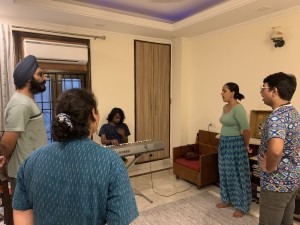 The idea is to explore, dream, create and adapt! It’s helpful to have a conductor to guide us and bring everyone together on the same page musically, although eventually it depends on the music. We’re also happy to have members take turns at leading and conducting the choir, it’s a very interesting art in itself!
The idea is to explore, dream, create and adapt! It’s helpful to have a conductor to guide us and bring everyone together on the same page musically, although eventually it depends on the music. We’re also happy to have members take turns at leading and conducting the choir, it’s a very interesting art in itself!
Moreover any song can be as sung as a choir, with a suitable arrangement. There are of course pieces specifically composed for choirs, but apart from this we explore songwriting andcomposition techniques to create our own songs as a choir!
“A huge part of my own musical learning happened as I sang with other people in the school and college choirs and in professional bands and ensembles. The Artistes Unlimited was a huge step in my musical journey and it was a diverse group of musicians working together. Not only does it create space to work together ans blend, but also to find our own unique space and voice, while being supported all along by other voices. The feeling of stepping out of a choir and singing a solo into a mic feels extremely empowering, and a big part of that is having other people and voices behind you, holding you up.”
Why is it important to sing with other people/sing in a group?
The choir culture has seen a decline in interest in the past few years as young singers have wished to explore their solo potential. Standing out in a crowd as an artist is the mantra that is instilled in us. Singing in a choir is in a sense a great way to let the music take centre stage. It also means connecting with each other over music, a joy that would be a pity to forget about. Singing with people as a collective also gives us the opportunity to build a new collective space and imagine a new reality, one that attempts to overcome the conflicts of our socio-political times – perhaps a new reality that is based on love, friendship and equality?
What kind of songs can be sung in an ensemble of this kind?
Absolutely any songs that interest us. A song with an elaborate harmonic arrangement is fun, and equally fun is the idea of creating parts for a song that may not have vocal harmonies.
Sometimes, the same melody can be harmonized by singing it as a canon. Instrumental songs can be transcribed into vocal parts emulating the sounds of different instruments.
Any language, any genre, in fact the more the merrier. The vocal circle is also a space to learn about different cultures using the songs as entry points.
VOCAL CIRCLE VOCABULARY
Polyphony: A type of music texture consisting of two or more simultaneous lines of independent melody.
Acapella: A vocal performance without instrumental accompaniment; originally intended to differentiate between Renaissance polyphony and Baroque concertato.
Motet: A motet is a piece of polyphonic choral music commonly associated with the Renaissance period of classical music; typically a Latin religious composition.
Concertato: A term in early Baroque music; groups of voices share a melody, usually in alternation, and almost always over a basso continuo. The term derives from Italian concerto which means “playing together”.
SATB: An initialism that describes the scoring of compositions for choirs; indicates a four part harmony comprising of soprano, alto, tenor and bass.
Partsong: A form of choral music that consists of a secular song arranged for several vocal parts; commonly sung by an SATB choir.
Soprano: It is the highest vocal range of all voice types; in ensemble singing it takes the highest part, which often encompasses the melody.
Alto: Meaning “high” in Italian; it is considered the second highest vocal range in choral music.
Tenor: Derives from the Latin word “tenere”, which means “to hold”; was the structurally fundamental (or “holding”) voice; between baritone and countertenor.
Bass: The lowest vocal range typically extending from around the second E below middle C to the E above middle C.
Chorale: It refers to a hymn, especially one with strong harmonisation; or a group of singers specialising in singing church music.
Baroque: Baroque period originated in Italy in the 17th century. It embraced a grandiose, dramatic, and energetic spirit as well as stylistic diversity.
Forms of Ensemble Singing
Indian Context
Ensemble singing in India has primarily been in the context of folk music such as Baul of Bengal, Maand of Rajasthan or Bihugeet of Assam. These involve groups of men and women singing in vernacular languages, typically to celebrate a festival, narrate a mythological story or welcome an agricultural season. Such forms of communal singing generate a societal effervescence that contribute to solidarity in times of crisis and collective joy in times of peace. It is likely a strong source of celebration, identity and assurance to members of a community. That apart, many choirs and artists collectives have emerged in some cities which are inspired by western traditions as well as Indian music.
India now boasts of some wonderfully talented ensembles such as the Capital City Minstrels, Artistes Unlimited, Christ Choir to name a few!
Gender Dynamics
Historically, ensemble singing, especially choirs, have been associated with rigid gender politics. There are concepts such as Castrato i.e. a type of classical male singing voice equivalent to that of a soprano that is produced by castration of the singer before puberty. This was to suit the needs of an all-male choir as women were banned by the dictum – “let women keep silent in the churches”. However, there is now a greater acceptance of mixed choirs . Infact globally famous choirs like Bella Voce or Elektra are composed of all-female voices. The notable change is thus this dissociation of gender and the SATB voice classification.
Singing as Protest
Whether it is the ‘Singing Revolution’ of Estonia in 1988, Call-and-Response songs during the US civil war, collective singing during the 1905 Swadeshi Movement of India, the activist choirs of Yugoslavia or the Italian anti-fascist song ‘Bella Ciao’ – singing in a group has long been recognised and utilised as one of the most powerful medium of protest and rebellion. It has the capacity to unite masses towards a common cause, and forge an impactful and non-aggressive form of expression. Since music is an integral part of society and as a consequence also mirrors many of its contradictions, activist choirs have not only been questioning the inequalities of society but also the SATB categorisations of traditional choral music. The ethnomusicologist Ana Hofman in her work on activist choirs mentions Horkeškart (Alternative Choir and Orchestra), feminist lesbian choir Le-zbor, Belgrade’s antifascist choir Naša Pjesma (Our song) and Domaćigosti (Hostguests), a choir that brings together refugees from the Middle East and Zagreb residents all of whom emphasise the idea of ‘All in One Voice’.
“My favourite part about the Vocal Circle is just how fun and relaxed the energy is during our sessions. There’s a lot of joking, a lot of laughter, the other facilitators are also a part of the group, and each week we try and work on a new piece together. In just the two months that I’ve been a part of the group I think we’ve already covered a lot of advanced concepts, but the process has felt really natural and very very comfortable. There’s something about singing with other people that’s so so fulfilling and I really really look forward to these sessions each.”
“When I came to Lilanoor, I was instantly nostalgic of my music classes from childhood. I joined the Vocal Circle and really enjoyed my classes. This was my first time learning choir music and singing in harmony. The teachers broke it down into simple exercises that made us understand harmony in an intuitive way. This formed a great foundation for those of us who were new to the practice. I thoroughly enjoyed both the theoretical and practical aspects of this class and even learned to read a bit of sheet music! My favourite part of the sessions was when we would bring together individual parts that we were practising. I realised that through the course of these classes I became sensitised to what different parts of the music add to the whole piece. It was a great experience and I would strongly recommend it!”
Playlist
Here is a collection of songs that you can harmonise to! Make up your own parts, or just hold the main melody – either way, it’s the magic of collective voices that makes these songs special!
Lilanoor Monthly Puzzle
Take a shot at the Word Circle, while reading about the Vocal Circle!
The idea is to make as many words as possible, with 4 letters or more, – and it is mandatory to use the letter in the centre! There is a bonus pat-on-the-back for those who can figure out the FULL-CIRCLE WORD i.e. one which uses ALL the letters of the wheel.
 HINT : It is the last name of a famous American conductor, globally known for his choral music. He is known for his concept of the Virtual Choir!
HINT : It is the last name of a famous American conductor, globally known for his choral music. He is known for his concept of the Virtual Choir!
With changing technology, and more fluidity in the rules of ensemble singing, fascinating concepts like the Virtual Choir have come up on the cyberstage! You must give it a listen!

HINT : It is the last name of a famous American conductor, globally known for his choral music. He is known for his concept of the Virtual Choir!
With changing technology, and more fluidity in the rules of ensemble singing, fascinating concepts like the Virtual Choir have come up on the cyberstage! You must give it a listen!
Puzzle Answer
ache, acre, care, cert, chew, cite, crew, each, etch, etic, hare, hate, hear, heat, heir, hire, race, rate, rice, rite, tace, tare, tear, tier, tire, ware, wear, wire, areic, caret, carte, cater, ceria, chare, cheat, chert, citer, crate, earth, erica, ethic, hater, heart, irate, ither, rathe, reach, react, recit, recta, recti, reich, retch, retia, tache, tawer, tawie, teach, terai, theca, their, threw, trace, trice, twice, twier, water, wecht, whare, wheat, white, withe, write, achier, cahier, chawer, cither, rachet, thawer, thrice, twicer, waiter, whiter, wither, wreath, wretch, writhe, rhaetic, theriac, watcher, WHITACRE
